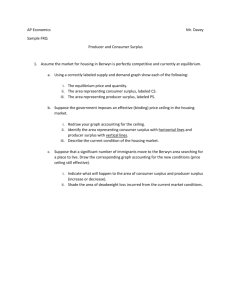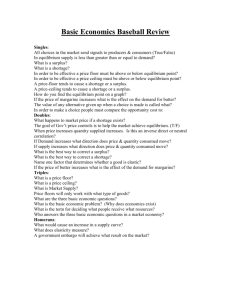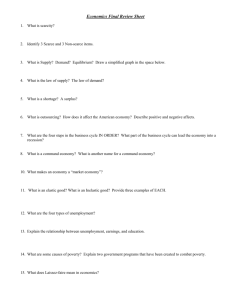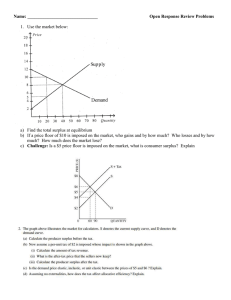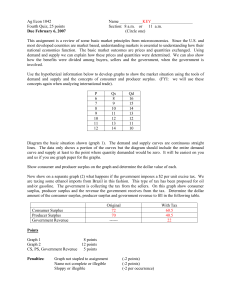Using Algebra
advertisement
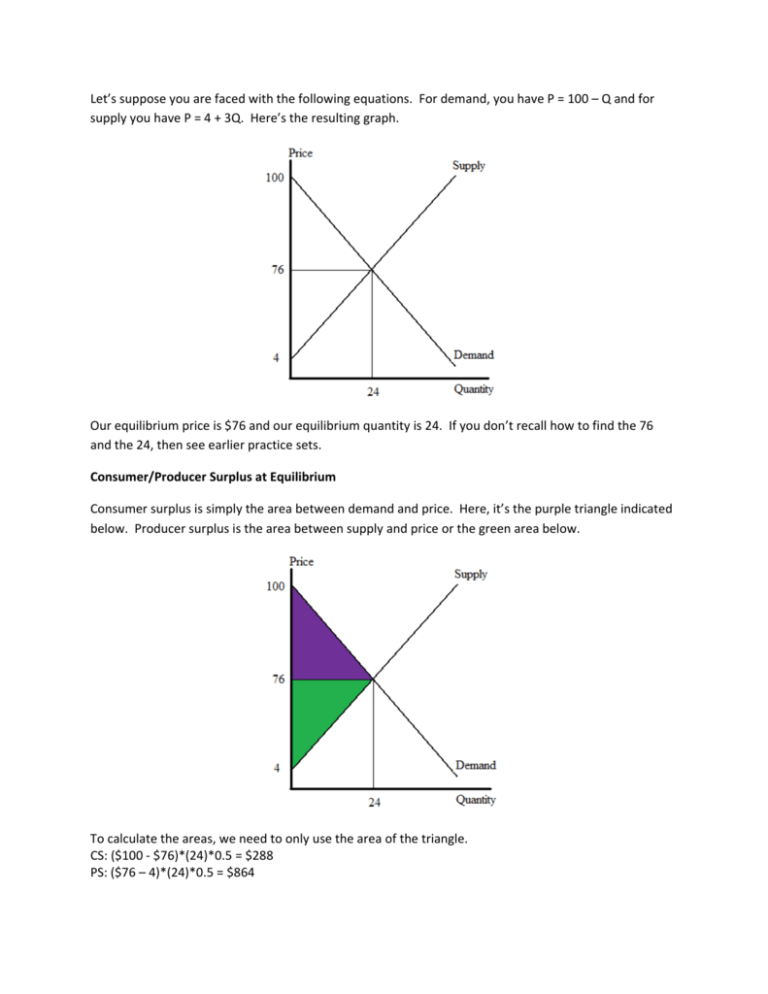
Let’s suppose you are faced with the following equations. For demand, you have P = 100 – Q and for supply you have P = 4 + 3Q. Here’s the resulting graph. Our equilibrium price is $76 and our equilibrium quantity is 24. If you don’t recall how to find the 76 and the 24, then see earlier practice sets. Consumer/Producer Surplus at Equilibrium Consumer surplus is simply the area between demand and price. Here, it’s the purple triangle indicated below. Producer surplus is the area between supply and price or the green area below. To calculate the areas, we need to only use the area of the triangle. CS: ($100 ‐ $76)*(24)*0.5 = $288 PS: ($76 – 4)*(24)*0.5 = $864 No problem. This would also be the result if we set a price ceiling above equilibrium or a price floor below equilibrium. Those are non‐binding and thus make no changes to our free market result. If you don’t recall where the 100 or 4 came from on the price axis, you need to review an earlier practice set. In the case of a binding price floor What if we wanted to put a price floor of $80? Let’s see how this affects our graph first. We’re going to have to figure out the quantities for “a” and “b”. “a” is a point on the demand curve, and “b” is a point on the supply curve. This is not a problem. We know that these quantities correspond with a price of $80 because that’s the price floor we implemented. To find these, we need only to put $80 in for price into the equations (into demand for “a”, into supply for “b”) and the Q we get will be our missing numbers. “a”: $80 = 100 – Q Put 80 in for P into demand Q = 20 Solve for Q “b”: $80 = 4 + 3Q Put 80 in for P into supply Q = 25.33 Solve for Q Now that we know the quantities, we can proceed. This is where we currently stand. CS is still the area between price and demand, so it’s the purple area. Note that the price now is $80 since that’s the statutory minimum. PS also remains the area between price and supply, and we again have to use $80 for the price. The new wrinkle here however is that our PS is chopped off on the right. As a seller, you can’t receive surplus beyond a quantity of 20 because no one is willing to purchase it. This results in a trapezoid (green). This also means we need to use our algebra to find one more missing quantity which is labeled “c”. Whether you’re using a trapezoid formula or combining a rectangle and triangle, you need “c”. But this is just a point on supply when quantity is 20. So, all I need to do is put in 20 for Q. “c”: P = 4 + 3(20) Put 20 in for Q into supply P = 64 Solve for P Now I know that “c” = 64. I can calculate my CS and PS. CS: ($20)*(20)*0.5 = $200 PS: ($76 + $16)*20*0.5 = $920, (using the trapezoid formula) My surplus is 25.33 – 20 = 5.33 My RM is 24 – 20 = 4 too few My DWL is (red) $16*4*0.5 = $32 Now that I’ve shown you how to do a price floor using equations, try to do a price ceiling of $50 using the same equations. The finished product is on the next page. Try to do it on your own first. Just looking at the answer won’t help you as much as working through and making mistakes. Qd: Qs: CS: PS: Shortage: RM: DWL: Get it correct? 50 15.33 ($50 + 34.67)*15.33*0.5 = $648.95, purple $46*15.33*0.5 = $352.59, green 50 – 15.33 = 34.67 24 – 15.33 = 8.67 too few $34.67*8.67*0.5 = $150.29, red



